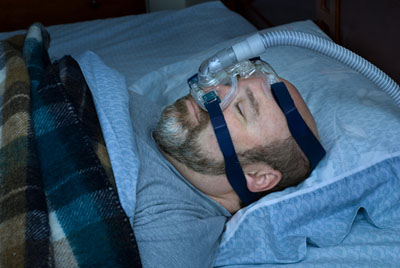|
Drivers with Sleep Apnea 7 Times More Likely to Crash
According to the Journal of Occupational and Environmental Medicine, truck drivers with sleep apnea have up to a seven-fold increased risk of being involved in a motor vehicle crash. Another study conducted by the University of Pennsylvania and sponsored by the Federal Motor Carrier Safety Administration (FMCSA) and the American Transportation Research Institute (ATRI) found that 28 percent of commercial truck and motorcoach drivers have some degree of sleep apnea.
Because of its prevalence and the danger the condition presents, the National Transportation Safety Board has recommended that FMCSA require commercial drivers to be screened for obstructive sleep apnea. Treating your drivers can increase the safety of your operation and result in significant cost savings in the form of reduced medical and insurance payments.

Sleep apnea is a potentially serious sleep disorder in which breathing repeatedly stops and starts. The most common type, obstructive sleep apnea, occurs when throat muscles relax, causing the airway to narrow or close. Obstructive sleep apnea is typically accompanied by loud snoring that may be punctuated by periods of silence. Central sleep apnea occurs when the brain fails to send the proper signals to the muscles that control breathing and complex sleep apnea is a combination of both types.
When breathing stops, the brain senses the inability to breathe and briefly rouses the individual in order to reopen the airway. This pattern may repeat itself more than 30 times each hour throughout the entire night. Although the interruptions are so brief the sleeper may not even recall them, they prohibit the body from reaching the desired, restful phases of sleep, causing daytime fatigue. This is especially problematic for professional drivers because fatigued driving, like driving under the influence of drugs or alcohol, impairs judgment, decreases awareness and slows reaction time.
If drivers feel they need to consume caffeine or energy drinks to stay awake while they are driving, they may have a sleep disorder that should be addressed with a physician. While caffeine can increase alertness, it takes time to enter the bloodstream and the effects may wear off after two or three hours. If drivers are extremely sleep deprived, they could still doze in and out of sleep for seconds at a time, regardless of the amount of caffeine they consume. Therefore, it is not a safe solution for drivers who are sleep deprived, particularly if their fatigue is the result of an ongoing condition such as sleep apnea.
The Federal Motor Carrier Safety Regulations (FMCSR) do not explicitly identify sleep apnea as a medical disqualifier, but Section 391.41(b)(5) states that “a person is physically qualified to drive a commercial motor vehicle if that person has no established medical history or clinical diagnosis of a respiratory dysfunction likely to interfere with the ability to control and drive a commercial motor vehicle safely.” Each state sets its own medical standards for operating a commercial motor vehicle (CMV) and many have determined that according to this regulation, sleep apnea is a disqualifying condition.
Even if your state does not disqualify drivers with sleep apnea, it is critical to be aware of the risk so that drivers who are affected by the condition can seek treatment. Individuals who are overweight; have a large neck; are 40 years of age or older; have a small upper airway, recessed chin, small jaw or large overbite; or smoke or drink alcohol may be at an increased risk of sleep apnea. Weight is such a prevalent indicator of sleep apnea that FMCSA has considered testing all drivers with a body mass index (BMI) of 30 or higher for the condition.
The Journal of Occupational and Environmental Medicine has reported that the health plan costs of drivers treated for sleep apnea decreased 41 percent over two years, compared to an eight percent decrease in drivers who remained untreated. In the study of 248 commercial drivers, treated drivers missed 4.4 fewer work days in the first year, compared to untreated drivers, and lowered their short-term disability costs by $528 over the two-year period.
Sleep apnea can be treated in a number of ways. Simple behavioral changes may be enough to combat the complications associated with the condition. Losing weight, avoiding alcohol and certain medications such as tranquilizers or sleeping pills, or sleeping on the side or abdomen rather than the back may successfully keep the airways open throughout the night. However, if these remedies are not effective, continuous positive airway pressure (CPAP) is a common medical treatment. CPAP requires patients to sleep with a small, lightweight mask over their nose or with padded prongs inside the nostrils. A specifically prescribed amount of air blows through the mask or prongs, forcing just enough air through the nostrils to prevent the throat from collapsing. Less common medical treatments include dental appliances for mild cases and surgery for the most severe cases.
{ back } |
